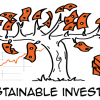In this video, I am going to show you how a truly sustainable business can exist only by dodging 4 key pitfalls. I am going to walk you through them one by one with real business examples.
Hi, my name is Alex. I have been working in sustainability for almost 20 years with dozens of businesses. I know how it feels: sustainability sounds great but Earth’s resources are like a shared pizza at a party—everyone’s grabbing slices, and if you snatch too many, the whole party crashes. So here is a simple framework that I have used in my work to make businesses thrive without trashing the planet. Ok, let’s get drawing!
Sustainability often feels overwhelming: No waste, zero pollution, 17 UN goals, circular economy—it’s a sustainability salad! But strip it down with science and thermodynamics (as explored in our previous video), and true sustainability boils down to only NOT doing four things. These are the unbreakable laws of nature and society, the guardrails that protect your business from risks while fostering efficiency and resilience.
First: Avoid contributing to the systematic buildup in nature of substances extracted from the Earth’s crust, such as fossil fuels and metals like lead, mercury, or cadmium. These are scarce resources that, when over-extracted, accumulate and disrupt ecosystems.
Picture your inbox. Say you can deal with 20 emails per day but now you get 30. Those extra 10 pile up relentlessly.
In practical terms, nature manages small natural flows—say, 100 to 600 tons of mercury annually—but humans extract 2,000 to 3,000 tons via industry and mining, leading to a sevenfold increase in concentrations that heighten environmental and health risks.
Not all elements are equal. Scarce ones like lead accumulate quickly, even in small amounts, much like salting a dish until it’s ruined. But abundant ones, like silicon or aluminum, integrate harmlessly.
Therefore, you need to conduct a material audit to identify risks, then substitute or implement closed-loop recycling. Tesla, for instance, minimizes rare metals in batteries and recycles over 90% of packs, reducing costs and supply chain vulnerabilities while boosting brand loyalty. It’s not about a sacrifice—it’s just smart resource management.
These principles empower flexibility: No prescribed path, just avoiding harm. Like in chess, victory comes in many forms as long as your opponent’s king canNOT move. Creativity reigns!
Second: Do NOT brew society’s Frankenstein chemicals that linger like a bad scent. Think PCBs, DDT, plastics, forever chemicals—man-made monsters that nature can’t break down quickly enough.
Examples: DDT banned after eagles nearly vanished; mountains of plastics in the ocean.
Solution: Inventory your chemicals, phase out the immortals, and cycle the rest. Patagonia transitioned to biodegradable, bluesign-certified fabrics, slashing environmental liabilities and appealing to eco-conscious markets for sustained revenue growth. Do you know other examples of businesses acting as sustainability champions? Share in the comments!
Third: Don’t bulldoze nature’s hardware. Deforestation, overfishing, soil stripping, aquifer draining—physical wrecking balls.
The key is alignment with regeneration rates: Harvest timber slower than regrowth, fish below reproduction thresholds. Unilever’s regenerative agriculture in tea plantations has allegedly increased yields by 20% while restoring soils, demonstrating how sustainability enhances operational efficiency and mitigates regulatory risks.
Fourth: Don’t sabotage people’s basics (health, education, influence, security) through practices that erode societal foundations.
Examples include lobbying against health policies or exploiting vulnerable labor.
Solutions: Ditch dodgy practices. Tony’s Chocolonely pays premiums to farmers, funding education and health while eliminating child labor—building resilient supply chains and premium pricing power.
IKEA is pioneering this: Sourcing 100% renewable or recycled wood, eliminating fossil fuels and toxics, advancing forest restoration (planting more than they harvest), and ensuring fair wages for over a million supply chain workers. The result? Reduced inequality, lower risks, and robust profits—showing sustainable models scale profitably.
Not only a truly sustainable business can exist but they make more money: this other video explains how they can make 51 to 81% more profit. Check it out and let me know what you think!






